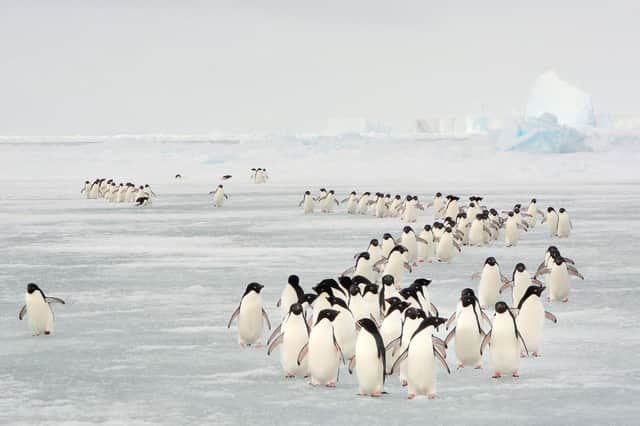Lets celebrate the penguins and meet them


They’re speedy swimmers, adorable waddlers, and movie stars thanks to leading roles in March of the Penguins, Happy Feet, Surf’s Up and Madagascar.
Let’s be honest, who doesn’t love penguins?
But although they one of the world’s favourite animals, how much do we actually know about the flightless birds?
Advertisement
Hide AdAdvertisement
Hide AdFor instance, did you know that a group of penguins in the water is called a raft, but on land they’re called a waddle?
And the black-and-white ‘tuxedo’ look donned by most species is actually a clever camouflage called countershading that disguises them from predators like leopard seals, sea lions, whales and sharks, and helps them catch prey like fish, squid, crabs and krill.
Penguins don’t have teeth, but instead utilise fleshy spines inside their mouths help them swallow fish.
While most species go through a ‘catastrophic molt’ once a year, penguins huddle together for several reasons, including to retain warmth and to protect themselves from predators.
Advertisement
Hide AdAdvertisement
Hide AdSome penguins species mate for life and many males gift females with rocks to woo them.
However, due to the intense fasting involved, the females often seek out chubbier guys who can go weeks without food while the ladies take their turn to hunt for fish.
There is a bit of disagreement on the exact number of penguin species, but there are generally thought to be around 18 types currently living on Earth – king, emperor, Adélie, chinstrap, gentoo, little, Magellanic, Humboldt, Galápagos, African, yellow-eyed, Fiordland, Snares, erect-crested, southern rockhopper, northern rockhopper, royal and macaroni.
In this special documentary, narrated by Liz Bonnin, viewers are introduced to them all.
Advertisement
Hide AdAdvertisement
Hide AdAlthough everyone imagines penguins on the ice in Antarctica or taking a break on a passing iceberg, we find out they are also found in South Africa, Chile, Peru, Galápagos Islands, New Zealand, Australia and a number of sub-Antarctic islands.
It is true though that penguins are very nearly exclusive to the southern hemisphere, and there are only a few living on the equator and in the northern hemisphere.
But here we meet penguins living in places where you wouldn’t expect to see them – dense forests, desert burrows and city streets. There is heartwarming footage of an emperor penguin chick stepping away from the safety of it father’s feet and experiencing its first flurry of snow.
Plus, while majestic king penguins swap their ragged feathers for a brand new outfit, audiences will also join different penguins as they battle the elements, face the perils of rock climbing and confront dangerous sea lions.
Advertisement
Hide AdAdvertisement
Hide AdWe will also see how these wonderful characters form lifelong bonds and become devoted parents, and discover how satellite imagery is revealing new penguin colonies we never knew existed before.
Doug Mackay-Hope, executive producer at BBC Studios Natural History Unit, said: “What I love about this show is that many of us feel we know penguins and yet if asked, most have no idea that there are 18 different varieties out there.
“From the striking snares penguin with its punk hairstyle to the little penguin with its blue feathers.
“In Penguins: Meet the Family we celebrate all of them for the first time, giving viewers a unique opportunity to meet and enjoy this much-loved animal family in a whole new light.”
Advertisement
Hide AdAdvertisement
Hide AdSo the next time you see a penguin on TV, in the cinema, in a zoo or even the wild, take a closer a look at what species it is – you may realise they are just as fascinating as they are are adorable.
A message from the Editor:
Thank you for reading this story on our website. While I have your attention, I also have an important request to make of you.
In order for us to continue to provide high quality and trusted local news on this free-to-read site, I am asking you to also please purchase a copy of our newspaper whenever you are able to do so.
Our journalists are highly trained and our content is independently regulated by IPSO to some of the most rigorous standards in the world. But being your eyes and ears comes at a price. So we need your support more than ever to buy our newspapers during this crisis.
Advertisement
Hide AdAdvertisement
Hide AdWith the coronavirus lockdown having a major impact on many of our local valued advertisers - and consequently the advertising that we receive - we are more reliant than ever on you helping us to provide you with news and information by buying a copy of our newspaper when you can safely.
You can also enjoy unlimited access to the best news from across Northern Ireland and the UK by subscribing to newsletter.co.uk
With a digital subscription, you can read more than five articles, see fewer ads, enjoy faster load times, and get access to exclusive newsletters and content. Visit https://www.newsletter.co.uk/subscriptions now to sign up.
Thank you